Co-Precipitated Ni-Mg-Al Hydrotalcite-Derived Catalyst Promoted with Vanadium for CO2 Methanation
Abstract
:1. Introduction
2. Results
2.1. Catalytic Tests
2.1.1. Temperature Programmed Surface Reaction
2.1.2. Stability Tests at 300 °C
2.2. Physico-Chemical Properties of V-Promoted Catalysts
2.2.1. Catalyst Reducibility
2.2.2. Low-Temperature N2 Sorption on Studied Catalysts
2.2.3. Evolution the Crystalline Structure of the Catalysts
2.2.4. Surface Basicity of the Reduced Catalysts
2.2.5. Morphology and Structure of Catalysts by Transmission Electron Microscopy
2.3. Post-Run Characterizations
3. Correlation between the Catalytic Activity and the Physico-Chemical Properties of the Ni-CP-VX Catalysts
4. Materials and Methods
5. Conclusions
Supplementary Materials
Author Contributions
Funding
Institutional Review Board Statement
Informed Consent Statement
Data Availability Statement
Acknowledgments
Conflicts of Interest
Sample Availability
References
- Karmalkar, A.V.; Bradley, R.S. Consequences of global warming of 1.5 °C and 2 °C for regional temperature and precipitation changes in the contiguous United States. PLoS ONE 2017, 12, e0168697. [Google Scholar] [CrossRef] [PubMed] [Green Version]
- Hughes, L. Biological consequences of global warming: Is the signal already apparent? Trends Ecol. Evol. 2000, 15, 56–61. [Google Scholar] [CrossRef]
- Matthews, T.K.R.; Wilby, R.L.; Murphy, C. Communicating the deadly consequences of global warming for human heat stress. Proc. Natl. Acad. Sci. USA 2017, 114, 3861–3866. [Google Scholar] [CrossRef] [PubMed] [Green Version]
- European Commission. Stepping up Europe’s 2030 climate ambition Investing in a climate-neutral future for the benefit of our people. J. Chem. Inf. Model. 2020, 53, 1689–1699. [Google Scholar]
- Rissman, J.; Bataille, C.; Masanet, E.; Aden, N.; Morrow, W.R.; Zhou, N.; Elliott, N.; Dell, R.; Heeren, N.; Huckestein, B.; et al. Technologies and policies to decarbonize global industry: Review and assessment of mitigation drivers through 2070. Appl. Energy 2020, 266, 114848. [Google Scholar] [CrossRef]
- Alper, E.; Yuksel Orhan, O. CO2 utilization: Developments in conversion processes. Petroleum 2017, 3, 109–126. [Google Scholar] [CrossRef]
- Wierzbicki, D.; Motak, M.; Grzybek, T.; Gálvez, M.E.; Da Costa, P. The influence of lanthanum incorporation method on the performance of nickel-containing hydrotalcite-derived catalysts in CO2 methanation reaction. Catal. Today 2018, 307, 205–211. [Google Scholar] [CrossRef]
- Sreedhar, I.; Varun, Y.; Singh, S.A.; Venugopal, A.; Reddy, B.M. Developmental trends in CO2 methanation using various catalysts. Catal. Sci. Technol. 2019, 9, 4478–4504. [Google Scholar] [CrossRef]
- Kuznecova, I.; Gusca, J. Property based ranking of CO and CO2 methanation catalysts. Energy Procedia 2017, 128, 255–260. [Google Scholar] [CrossRef]
- Olesen, S.E.; Andersson, K.J.; Damsgaard, C.D.; Chorkendorff, I. Deactivating Carbon Formation on a Ni/Al2O3 Catalyst under Methanation Conditions. J. Phys. Chem. C 2017, 121, 15556–15564. [Google Scholar] [CrossRef]
- Wierzbicki, D.; Baran, R.; Dębek, R.; Motak, M.; Grzybek, T.; Gálvez, M.E.; Da Costa, P. The influence of nickel content on the performance of hydrotalcite-derived catalysts in CO2 methanation reaction. Int. J. Hydrogen Energy 2017, 42, 23548–23555. [Google Scholar] [CrossRef]
- Liu, Q.; Gu, F.; Zhong, Z.; Xu, G.; Su, F. V-promoted Ni/Al2O3 catalyst for synthetic natural gas (SNG) production: Catalyst preparation methodologies. Korean J. Chem. Eng. 2016, 33, 1599–1605. [Google Scholar] [CrossRef]
- Cavani, F.; Trifiro, F.; Vaccari, A. Hydrotalcite-type anionic clays: Preparation, properties and applications. Catal. Today 1991, 11, 173–301. [Google Scholar] [CrossRef]
- Prinetto, F.; Ghiotti, G.; Das, N.; Tichit, D.; Coq, B. Characterisation of palladium catalysts supported on hydrotalcite-derived mixed oxides. In Oxide-Based Systems at the Crossroads of Chemistry; Gamba, A., Colella, C., Coluccia, S., Eds.; Studies in Surface Science and Catalysis; Elsevier: Amsterdam, The Netherlands, 2001; Volume 140, pp. 391–400. [Google Scholar]
- Wang, S.; Pan, Q.; Peng, J.; Sun, T.; Gao, D.; Wang, S. CO2 methanation on Ni/Ce0.5Zr0.5O2 catalysts for the production of synthetic natural gas. Fuel Process. Technol. 2014, 123, 166–171. [Google Scholar] [CrossRef]
- Ma, S.; Tan, Y.; Han, Y. Methanation of syngas over coral reef-like Ni/Al2O3 catalysts. J. Nat. Gas Chem. 2011, 20, 435–440. [Google Scholar] [CrossRef]
- Dębek, R.; Radlik, M.; Motak, M.; Galvez, M.E.; Turek, W.; Da Costa, P.; Grzybek, T. Ni-containing Ce-promoted hydrotalcite derived materials as catalysts for methane reforming with carbon dioxide at low temperature—On the effect of basicity. Catal. Today 2015, 257, 59–65. [Google Scholar] [CrossRef]
- Summa, P.; Samojeden, B.; Motak, M.; Wierzbicki, D.; Alxneit, I.; Świerczek, K.; Da Costa, P. Investigation of Cu promotion effect on hydrotalcite-based nickel catalyst for CO2 methanation. Catal. Today 2021. [Google Scholar] [CrossRef]
- Bahari, M.B.; Nguyen, T.D.; Singh, S.; Siang, T.J.; Shafiqah, M.N.N.; Jun, L.N.; Phuong, P.T.T.; Ainirazali, N.; Vo, D.V.N. Catalytic performance of yttrium-doped co/mesoporous alumina catalysts for methane dry reforming. AIP Conf. Proc. 2019, 2124. [Google Scholar] [CrossRef]
- Tsiotsias, A.I.; Charisiou, N.D.; Yentekakis, I.V.; Goula, M.A. Bimetallic ni-based catalysts for CO2 methanation: A review. Nanomaterials 2021, 11, 28. [Google Scholar] [CrossRef]
- Wierzbicki, D.; Debek, R.; Motak, M.; Grzybek, T.; Gálvez, M.E.; Da Costa, P. Novel Ni-La-hydrotalcite derived catalysts for CO2 methanation. Catal. Commun. 2016, 83, 5–8. [Google Scholar] [CrossRef] [Green Version]
- Wierzbicki, D.; Baran, R.; Dębek, R.; Motak, M.; Gálvez, M.E.; Grzybek, T.; Da Costa, P.; Glatzel, P. Examination of the influence of La promotion on Ni state in hydrotalcite-derived catalysts under CO2 methanation reaction conditions: Operando X-ray absorption and emission spectroscopy investigation. Appl. Catal. B Environ. 2018, 232, 409–419. [Google Scholar] [CrossRef]
- Maluf, S.S.; Assaf, E.M. Ni catalysts with Mo promoter for methane steam reforming. Fuel 2009, 88, 1547–1553. [Google Scholar] [CrossRef]
- Xu, L.; Lian, X.; Chen, M.; Cui, Y.; Wang, F.; Li, W.; Huang, B. CO2 methanation over Co–Ni bimetal-doped ordered mesoporous Al2O3 catalysts with enhanced low-temperature activities. Int. J. Hydrogen Energy 2018, 43, 17172–17184. [Google Scholar] [CrossRef]
- Cao, H.X.; Zhang, J.; Guo, C.L.; Chen, J.G.; Ren, X.K. Modifying surface properties of KIT-6 zeolite with Ni and V for enhancing catalytic CO methanation. Appl. Surf. Sci. 2017, 426, 40–49. [Google Scholar] [CrossRef]
- Carabineiro, S.A.; Brás Fernandes, F.; Ramos, A.M.; Vital, J.; Silva, I.F. Vanadium as a catalyst for NO, N2O and CO2 reaction with activated carbon. Catal. Today 2000, 57, 305–312. [Google Scholar] [CrossRef]
- Shahul Hamid, M.Y.; Abdul Jalil, A.; Abdul Rahman, A.F.; Tuan Abdullah, T.A. Enhanced reactive CO2 species formation: Via V2O5-promoted Ni/KCC-1 for low temperature activation of CO2 methanation. React. Chem. Eng. 2019, 4, 1126–1135. [Google Scholar] [CrossRef]
- Lu, X.; Gu, F.; Liu, Q.; Gao, J.; Liu, Y.; Li, H.; Jia, L.; Xu, G.; Zhong, Z.; Su, F. VOx promoted Ni catalysts supported on the modified bentonite for CO and CO2 methanation. Fuel Process. Technol. 2015, 135, 34–46. [Google Scholar] [CrossRef]
- Cao, H.; Wang, W.; Cui, T.; Wang, H.; Zhu, G.; Ren, X. Enhancing CO2 hydrogenation to methane by ni-based catalyst with v species using 3d-mesoporous kit-6 as support. Energies 2020, 13, 2235. [Google Scholar] [CrossRef]
- Dula, R.; Wcislo, K.; Stoch, J.; Grzybowska, B.; Serwicka, E.M.; Kooli, F.; Bahranowski, K.; Gawel, A. Layered double hydroxide-derived vanadium catalysts for oxidative dehydrogenation of propane: Influence of interlayer-doping versus layer-doping. Appl. Catal. A Gen. 2002, 230, 281–291. [Google Scholar] [CrossRef]
- Bahranowski, K.; Dula, R.; Kooli, F.; Serwicka, E.M. ESR study of the thermal decomposition of V-containing layered double hydroxides. Colloids Surfaces A Physicochem. Eng. Asp. 1999, 158, 129–136. [Google Scholar] [CrossRef]
- Świrk, K.; Summa, P.; Wierzbicki, D.; Motak, M.; Da Costa, P. Vanadium promoted Ni(Mg,Al)O hydrotalcite-derived catalysts for CO2 methanation. Int. J. Hydrogen Energy 2021, 46, 17776–17783. [Google Scholar] [CrossRef]
- Le, T.A.; Kim, J.; Kang, J.K.; Park, E.D. CO and CO2 methanation over M (M = Mn, Ce, Zr, Mg, K, Zn, or V)-promoted Ni/Al@Al2O3 catalysts. Catal. Today 2020, 348, 80–88. [Google Scholar] [CrossRef]
- Dębek, R.; Motak, M.; Galvez, M.E.; Grzybek, T.; Da Costa, P. Influence of Ce/Zr molar ratio on catalytic performance of hydrotalcite-derived catalysts at low temperature CO2 methane reforming. Int. J. Hydrogen Energy 2017, 42, 23556–23567. [Google Scholar] [CrossRef]
- Meira, D.M.; Cortez, G.G.; Monteiro, W.R.; Rodrigues, J.A.J. Vanadium oxides supported on hydrotalcite-type precursors: The effect of acid-base properties on the oxidation of isopropanol. Braz. J. Chem. Eng. 2006, 23, 351–358. [Google Scholar] [CrossRef] [Green Version]
- Garbarino, G.; Kowalik, P.; Riani, P.; Antoniak-Jurak, K.; Pieta, P.; Lewalska-Graczyk, A.; Lisowski, W.; Nowakowski, R.; Busca, G.; Pieta, I.S. Improvement of Ni/Al2O3 catalysts for low-temperature CO2 methanation by vanadium and calcium oxide addition. Ind. Eng. Chem. Res. 2021, 60, 6554–6564. [Google Scholar] [CrossRef]
- Alothman, Z.A. A review: Fundamental aspects of silicate mesoporous materials. Materials 2012, 5, 2874. [Google Scholar] [CrossRef] [Green Version]
- Wierzbicki, D.; Moreno, M.V.; Ognier, S.; Motak, M.; Grzybek, T.; Da Costa, P.; Gálvez, M.E. Ni-Fe layered double hydroxide derived catalysts for non-plasma and DBD plasma-assisted CO2 methanation. Int. J. Hydrogen Energy 2020, 45, 10423–10432. [Google Scholar] [CrossRef]
- Sukkathanyawat, H.; Tungkamani, S.; Phongaksorn, M.; Rattana, T.; Narataruksa, P.; Yoosuk, B. Promoter Effect on the Physico-chemical Properties of Cobalt Based Catalyst for CO Hydrogenation. Energy Procedia 2015, 79, 372–377. [Google Scholar] [CrossRef] [Green Version]
- Valcheva-Traykova, M.L.; Davidova, N.P.; Weiss, A.H. Thermal decomposition of Mg, Al-hydrotalcite material. J. Mater. Sci. 1993, 28, 2157–2162. [Google Scholar] [CrossRef]
- Chmielarz, L.; Rutkowska, M.; Kuśtrowski, P.; Drozdek, M.; Piwowarska, Z.; Dudek, B.; Dziembaj, R.; Michalik, M. An influence of thermal treatment conditions of hydrotalcite-like materials on their catalytic activity in the process of N2O decomposition. J. Therm. Anal. Calorim. 2011, 105, 161–170. [Google Scholar] [CrossRef] [Green Version]
- Świrk, K.; Gálvez, M.E.; Motak, M.; Grzybek, T.; Rønning, M.; Da Costa, P. Yttrium promoted Ni-based double-layered hydroxides for dry methane reforming. J. CO2 Util. 2018, 27, 247–258. [Google Scholar] [CrossRef]
- Aziz, M.A.A.; Jalil, A.A.; Wongsakulphasatch, S.; Vo, D.V.N. Understanding the role of surface basic sites of catalysts in CO2 activation in dry reforming of methane: A short review. Catal. Sci. Technol. 2020, 10, 35–45. [Google Scholar] [CrossRef]
- Alxneit, I. Particle Size Distributions from Electron Microscopy Images: Avoiding Pitfalls. J. Phys. Chem. A 2020, 24, 10075–10081. [Google Scholar] [CrossRef]
- Liu, Q.; Gu, F.; Lu, X.; Liu, Y.; Li, H.; Zhong, Z.; Xu, G.; Su, F. Enhanced catalytic performances of Ni/Al2O3 catalyst via addition of V2O3 for CO methanation. Appl. Catal. A Gen. 2014, 488, 37–47. [Google Scholar] [CrossRef]
- Guil-Lopez, R.; Navarro, R.M.; Ismail, A.A.; Al-Sayari, S.A.; Fierro, J.L.G. Influence of Ni environment on the reactivity of Ni-Mg-Al catalysts for the acetone steam reforming reaction. Int. J. Hydrogen Energy 2015, 40, 5289–5296. [Google Scholar] [CrossRef]
- Shen, Y.; Ge, M.; Lua, A.C. Deactivation of bimetallic nickel-copper alloy catalysts in thermocatalytic decomposition of methane. Catal. Sci. Technol. 2018, 8, 3853–3862. [Google Scholar] [CrossRef]
- Reimnitz, L.C.; Lwin, T.; Lopez, M.; Milliron, D.J. Oxygen storage in transition metal-doped bixbyite vanadium sesquioxide nanocrystals. ChemRxiv 2020, 3, 9645–9651. [Google Scholar] [CrossRef]
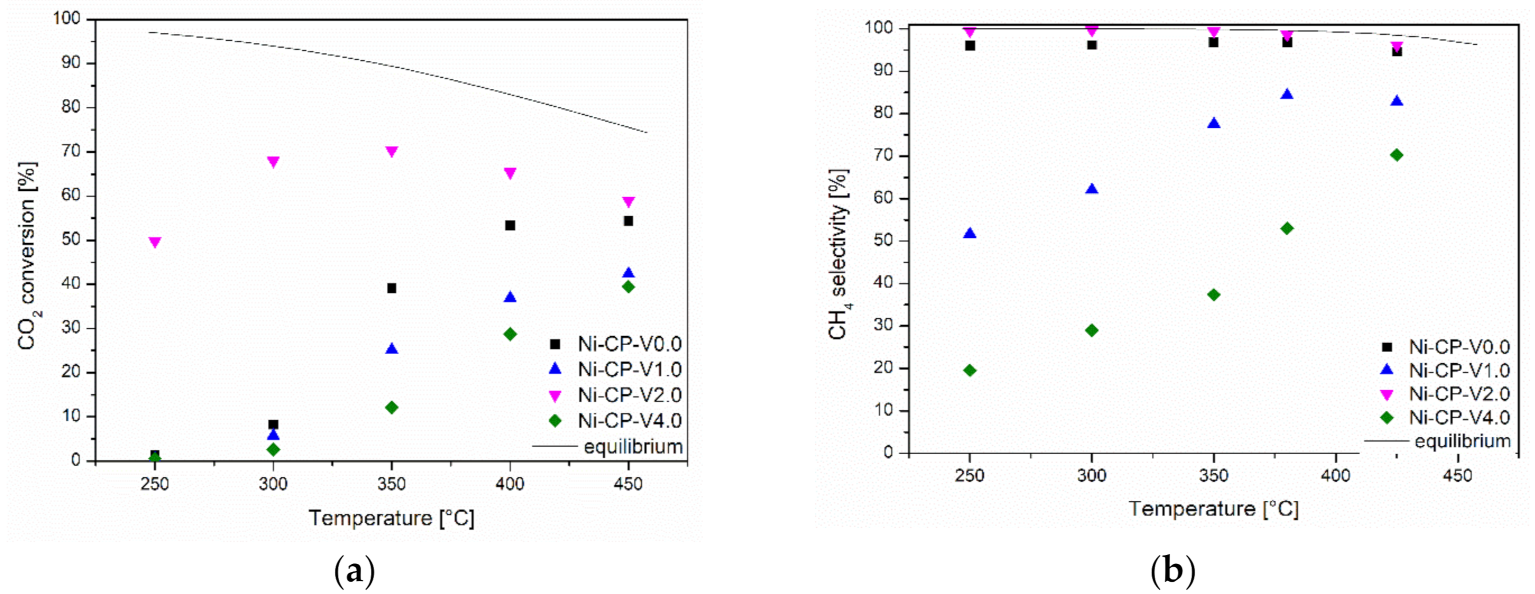

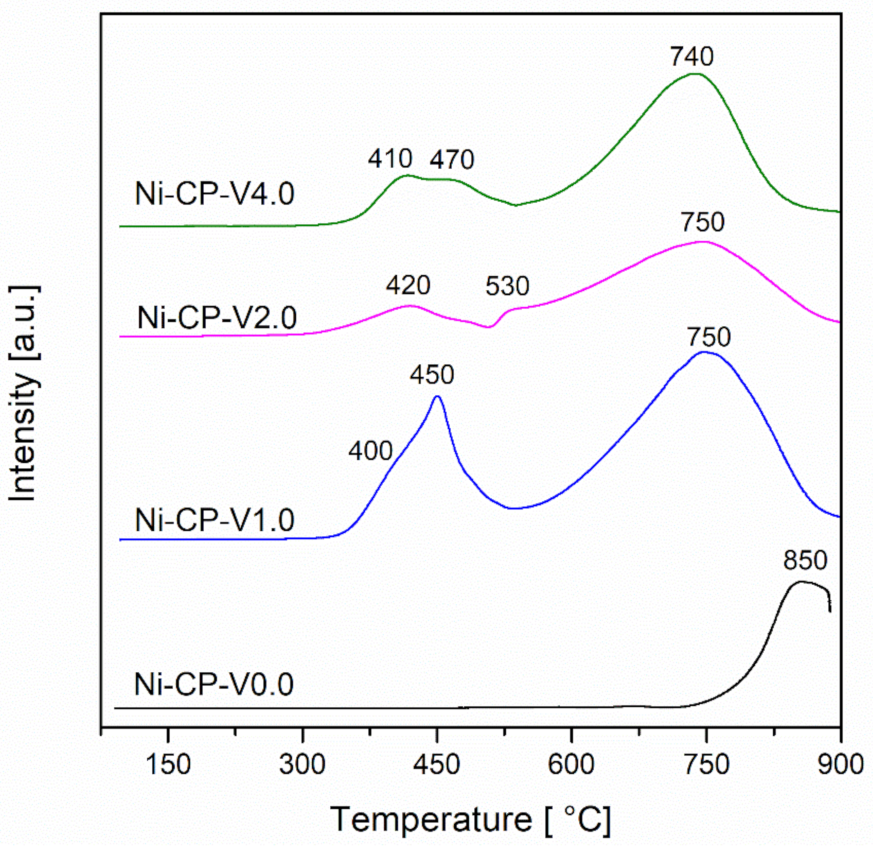

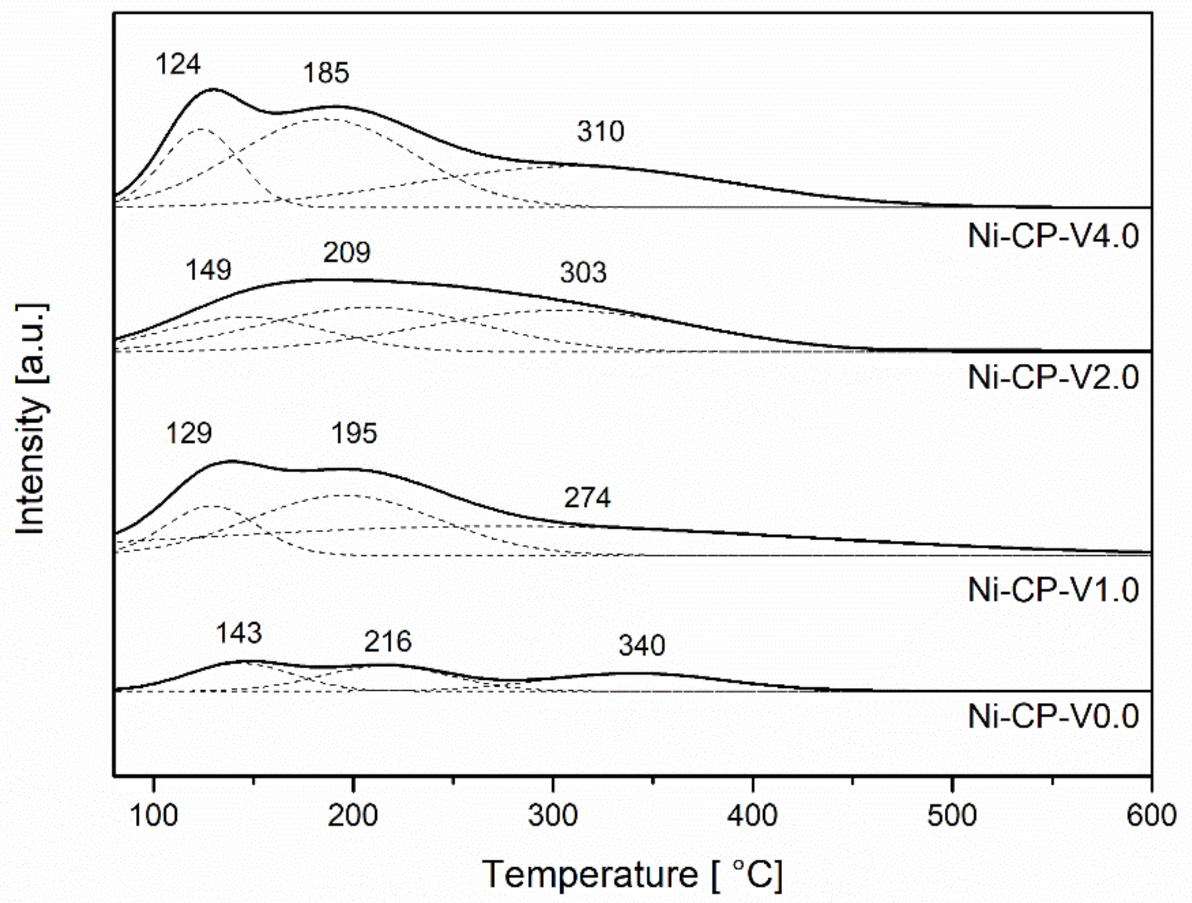

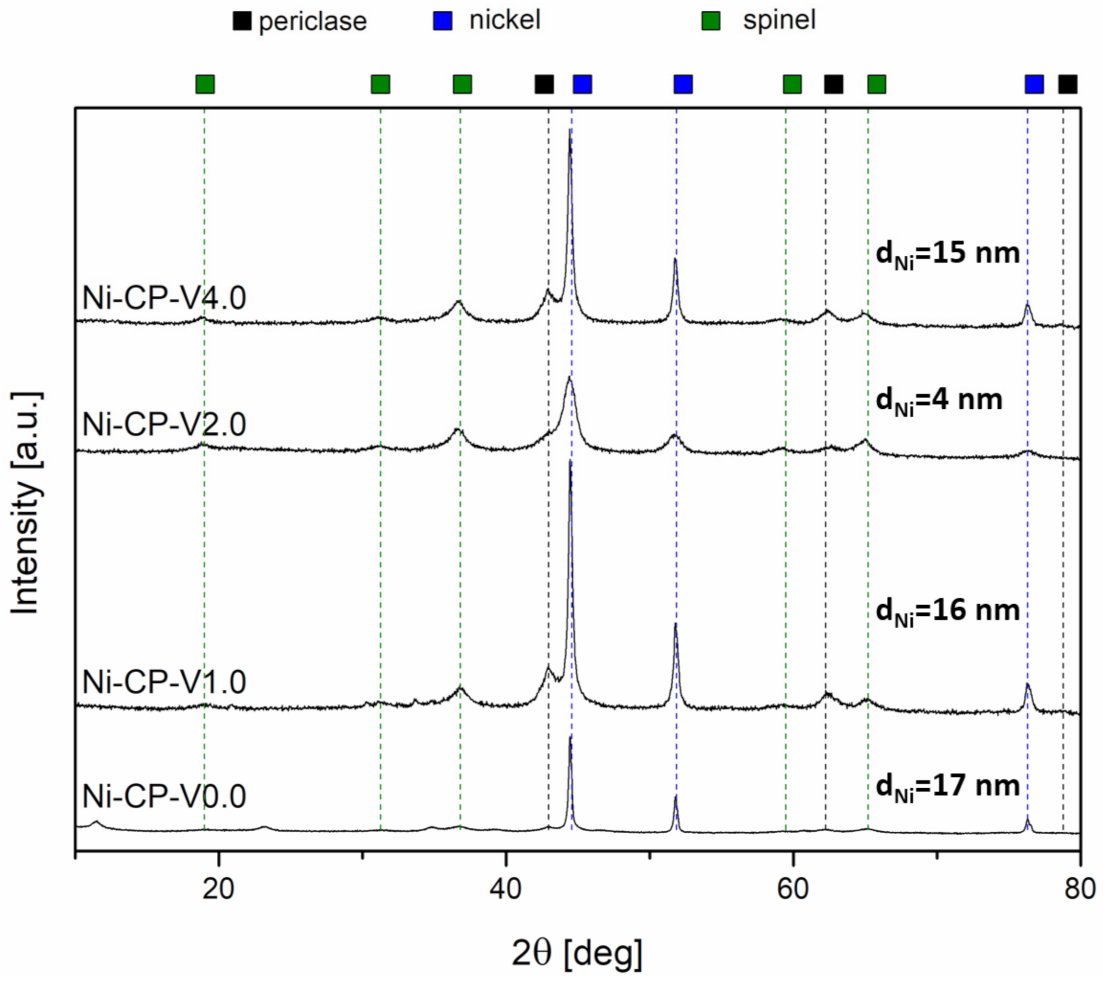

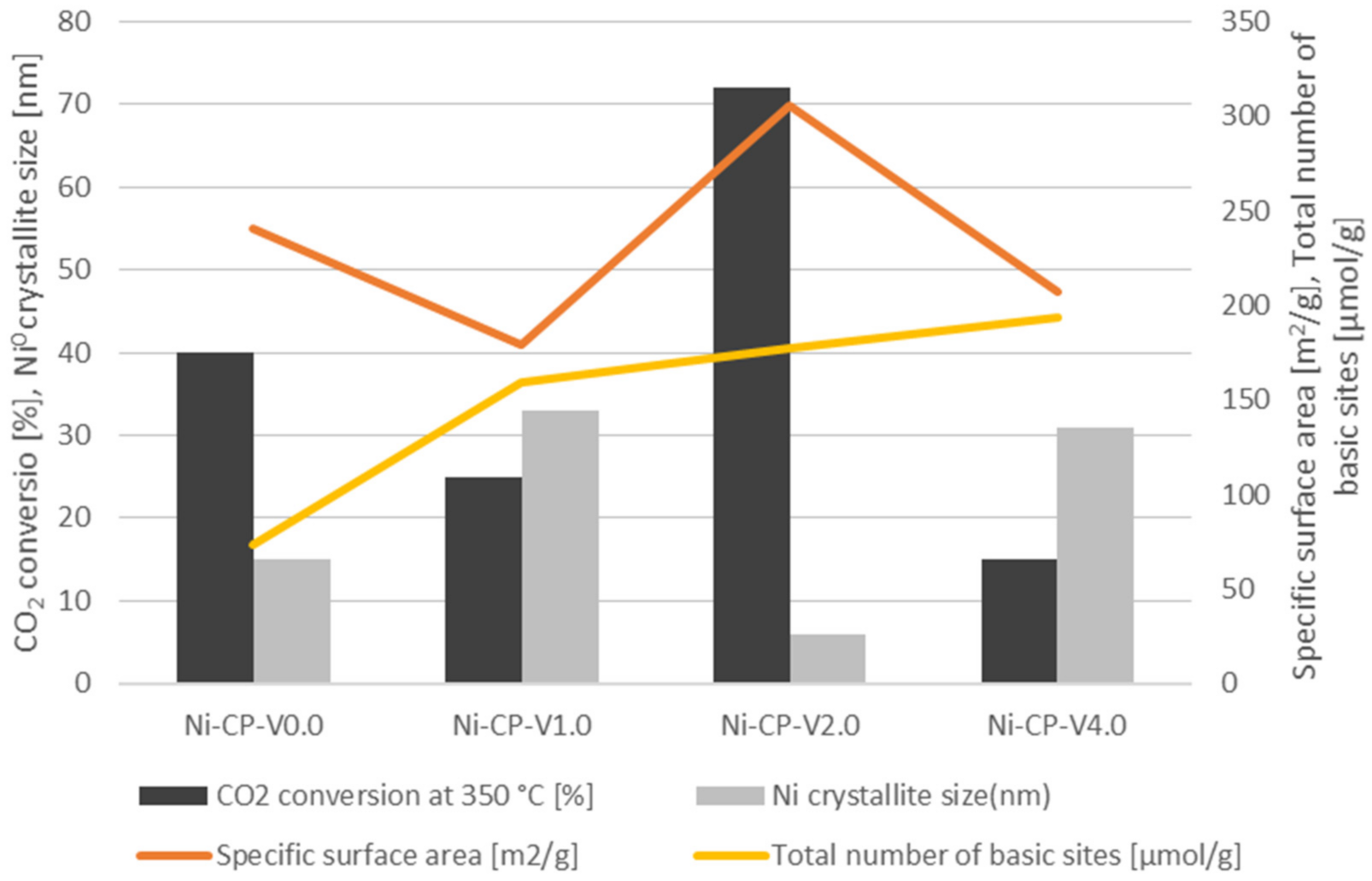
| Sample | Ni-CP-V0.0 | Ni-CP-V1.0 | Ni-CP-V2.0 | Ni-CP-V4.0 |
|---|---|---|---|---|
| TOF [10−2 s−1] | 1.2 | 3.5 | 7.9 | 3.1 |
| D | 0.08 | 0.04 | 0.07 | 0.04 |
| Sample | SBET [m2/g] | Mean Pore Diameter [nm] | Mesopore Volume [cm3/g] | Isotherm Type |
|---|---|---|---|---|
| Ni-CP-V0.0 | 241 | 10 | 0.42 | IV—H1 |
| Ni-CP-V1.0 | 179 | 10 | 0.18 | IV—H1 |
| Ni-CP-V2.0 | 306 | 11 | 0.70 | IV—H1 |
| Ni-CP-V4.0 | 207 | 10 | 0.22 | IV—H1 |
| Sample | Share of Crystalline Phase | Ni0 Crystallite Size [nm] | |||
|---|---|---|---|---|---|
| Spinel [%] | Periclase [%] | Nickel [%] | XRD | TEM | |
| Ni-CP-V0.0 | 28.6 | 52.9 | 18.5 | 15 | 12 |
| Ni-CP-V1.0 | 36.2 | 36.8 | 26.9 | 33 | 28 |
| Ni-CP-V2.0 | 42 | 38.9 | 19.1 | 6 | 15 |
| Ni-CP-V4.0 | 50.1 | 23.5 | 26.3 | 31 | 28 |
| Sample | Basic Sites [μmol/g] | Basic Sites Distribution [%] | |||||
|---|---|---|---|---|---|---|---|
| Weak | Medium | Strong | Total | Weak | Medium | Strong | |
| Ni-CP-V0.0 | 23 | 25 | 25 | 73 | 32 | 34 | 34 |
| Ni-CP-V1.0 | 36 | 86 | 37 | 159 | 23 | 54 | 23 |
| Ni-CP-V2.0 | 51 | 71 | 55 | 177 | 29 | 40 | 31 |
| Ni-CP-V4.0 | 37 | 98 | 59 | 194 | 19 | 51 | 30 |
Publisher’s Note: MDPI stays neutral with regard to jurisdictional claims in published maps and institutional affiliations. |
© 2021 by the authors. Licensee MDPI, Basel, Switzerland. This article is an open access article distributed under the terms and conditions of the Creative Commons Attribution (CC BY) license (https://creativecommons.org/licenses/by/4.0/).
Share and Cite
Summa, P.; Świrk, K.; Wierzbicki, D.; Motak, M.; Alxneit, I.; Rønning, M.; Da Costa, P. Co-Precipitated Ni-Mg-Al Hydrotalcite-Derived Catalyst Promoted with Vanadium for CO2 Methanation. Molecules 2021, 26, 6506. https://doi.org/10.3390/molecules26216506
Summa P, Świrk K, Wierzbicki D, Motak M, Alxneit I, Rønning M, Da Costa P. Co-Precipitated Ni-Mg-Al Hydrotalcite-Derived Catalyst Promoted with Vanadium for CO2 Methanation. Molecules. 2021; 26(21):6506. https://doi.org/10.3390/molecules26216506
Chicago/Turabian StyleSumma, Paulina, Katarzyna Świrk, Dominik Wierzbicki, Monika Motak, Ivo Alxneit, Magnus Rønning, and Patrick Da Costa. 2021. "Co-Precipitated Ni-Mg-Al Hydrotalcite-Derived Catalyst Promoted with Vanadium for CO2 Methanation" Molecules 26, no. 21: 6506. https://doi.org/10.3390/molecules26216506
APA StyleSumma, P., Świrk, K., Wierzbicki, D., Motak, M., Alxneit, I., Rønning, M., & Da Costa, P. (2021). Co-Precipitated Ni-Mg-Al Hydrotalcite-Derived Catalyst Promoted with Vanadium for CO2 Methanation. Molecules, 26(21), 6506. https://doi.org/10.3390/molecules26216506








